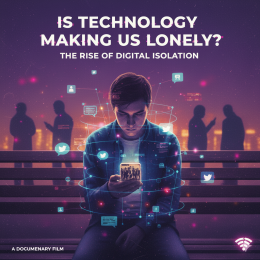
Is Technology Making Us Lonely? The Rise of Digital Isolation
2025-10-25 13:36:32In an age where we're more connected than ever - through smartphones, social media, and instant messaging - it might seem like loneliness should be a thing of the past. Yet, paradoxically, digital loneliness is on the rise.
We scroll, we post, we connect...but are we truly connected?
This paradox of the modern world - hyperconnectivity leading to emotional disconnection - is at the heart of a growing global concern: digital isolation.
The Paradox of Connectivity
Technology was meant to bring people closer. From video calls across continents to online communities for every interest, the internet promised to shrink the world.
But somewhere along the way, the virtual world began to replace the real one.
We started choosing screens over conversations, texts over touch, and notifications over nuance.
In doing so, we've created an illusion of connection - a digital crowd but emotional solitude.
Alone Together - The New Reality
Sociologist Sherry Turkle coined a phrase that perfectly captures our times: Alone Together.
It means being surrounded by people online yet feeling emotionally disconnected.
You might have hundreds of followers or group chats, but still struggle to find one person to truly talk to.
How Technology Impacts Our Mental Health
While technology offers immense benefits, excessive or unmindful use can have serious effects on mental health:
1. Reduced Face-to-Face Interaction
Human beings thrive on emotional presence - tone, touch, and eye contact.
When most of our communication happens through screens, we lose that emotional depth.
This can increase feelings of loneliness, anxiety, and social withdrawal.
2. Social Media Comparison Trap
Scrolling through perfect photos and success stories can create unrealistic expectations.
This constant comparison leads to low self-esteem, depression, and body image issues.
3. Sleep Deprivation and Overstimulation
The blue light from screens disrupts natural sleep cycles.
Late-night scrolling keeps the brain active, increasing stress and emotional fatigue.
4. FOMO - Fear of Missing Out
Constant notifications make people feel like they must stay updated.
This hyper-awareness causes restlessness, anxiety, and even burnout.
5. Isolation in the Digital Era
Ironically, even though we connect 24\7, most online interactions are surface-level.
Meaningful relationships - the kind that nurture emotional well-being - are often neglected.
Signs of Digital Loneliness
It's not always obvious when technology starts affecting your mental health.
Here are some warning signs that you might be experiencing digital isolation:
You spend hours online but still feel emotionally drained.
You check your phone repeatedly for no real reason.
You prefer texting over meeting people in person.
You feel disconnected even in social gatherings.
You often compare your life to others on social media.
You struggle to focus without digital stimulation.
If these sound familiar, it's time to pause and reflect.
How to Overcome Digital Isolation
Digital loneliness isn't irreversible. The key is mindful usage - using technology as a tool, not a trap.
Here are a few ways to regain emotional balance and rebuild real connections:
1. Set Digital Boundaries
Create tech-free zone in your day - especially during meals, mornings, and before bed.
Try a digital detox weekend once a month.
2. Prioritize Face-to-Face Conversations
Call your friends. Meet,family. Talk without screens.
Genuine emotional exchange boosts oxytocin, the connection hormone, improving mental well-being.
3. Be Intentional with Social Media
Follow accounts that inspire or educate, not those that trigger comparison or anxiety.
Use social media to connect - not to compete.
4. Practice Mindfulness and Self-Awareness
Be aware of your emotions while using technology.
Ask yourself: Is this adding value to my life or draining my energy?
5. Join Real Communities
Join hobby clubs, volunteering programs, or mental health groups offline.
Human connection remains the most powerful antidote to loneliness.
6. Seek Professional Help
If digital isolation has started affecting your sleep, mood, or motivation, therapy can help.
At CIIMHANS (Chhattisgarh Institute of Mental Health and Neuro Sciences), our experts specialize in digital wellness, social anxiety, and emotional regulation.
You don't have to face this alone - help is always available.
How Technology Can Be Used for Good
Not all technology is harmful. When used mindfully, it can enhance emotional health:
Mental health apps can help track moods and manage stress.
Online therapy platforms offer help to people in remote areas.
Support groups and wellness communities connect individuals with shared experiences.
The goal is balance - using technology as an aid, not an escape.
Reconnecting with What Matters
True connection happens when we are present, emotionally available, and empathetic - qualities no technology can replace.
Start small:
Put your phone away during meals.
Take a walk without music.
Talk to someone face-to-face.
Listen, really listen.
These simple acts bring back the warmth of human connection that technology can never replicate.
Remember: Your mental health thrives on real connection, not virtual validation.
The Road Back to Emotional Balance
Digital isolation is one of the silent mental health challenges of our generation.
But with awareness, boundaries, and compassion, we can reclaim our peace.
At CIIMHANS, we believe in helping individuals create a balanced relationship with technology - where digital tools serve your growth, not control your emotions.
If you or someone you know is struggling with digital fatigue, anxiety, or loneliness, reach out today.
